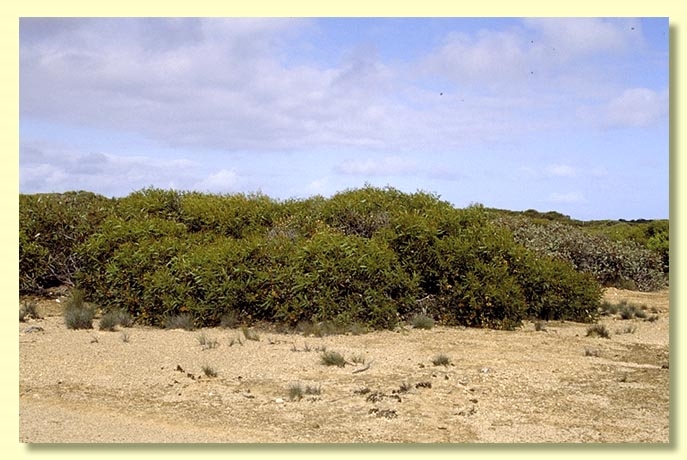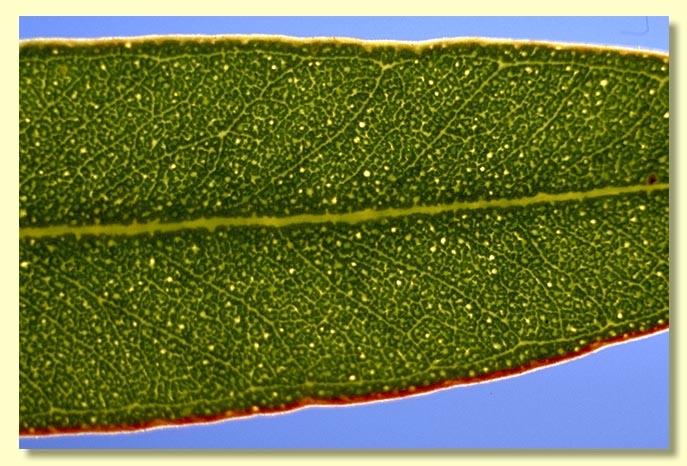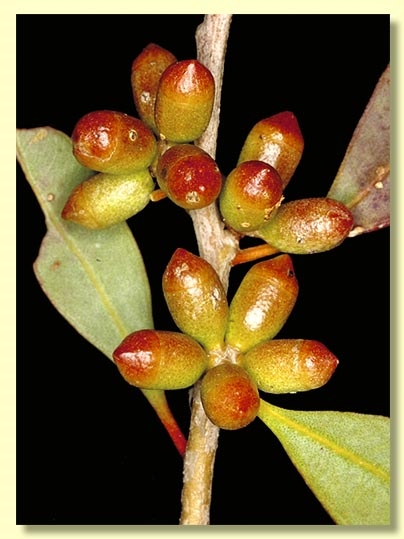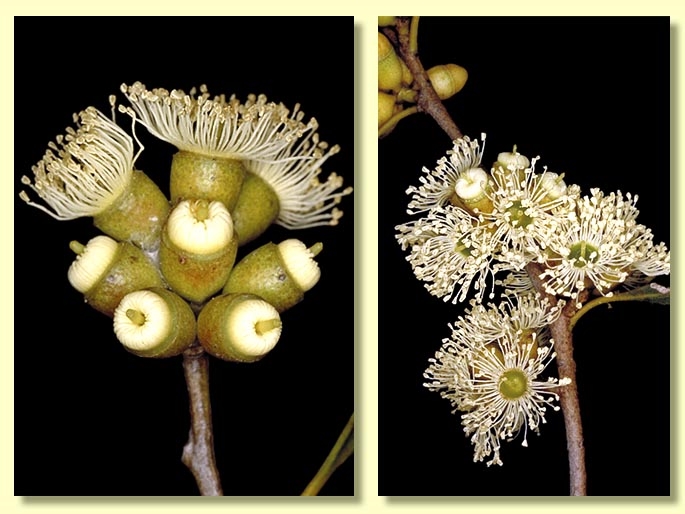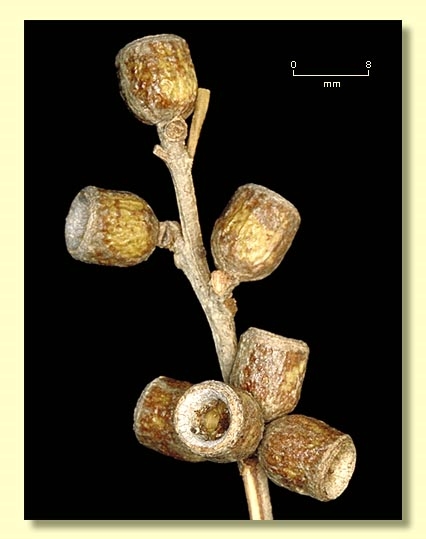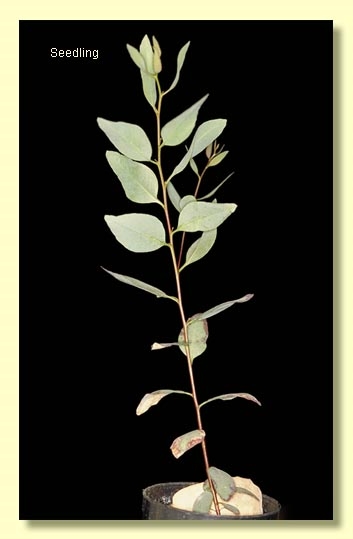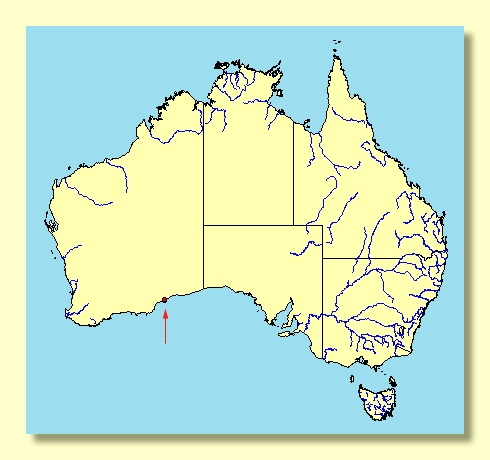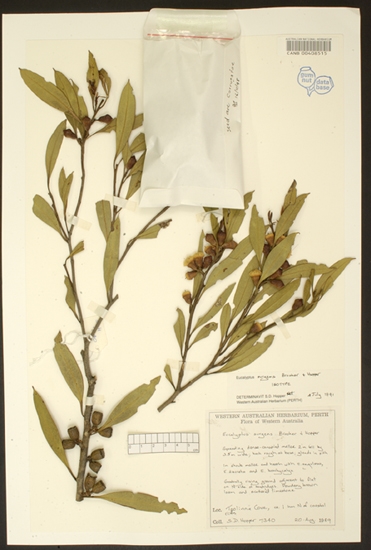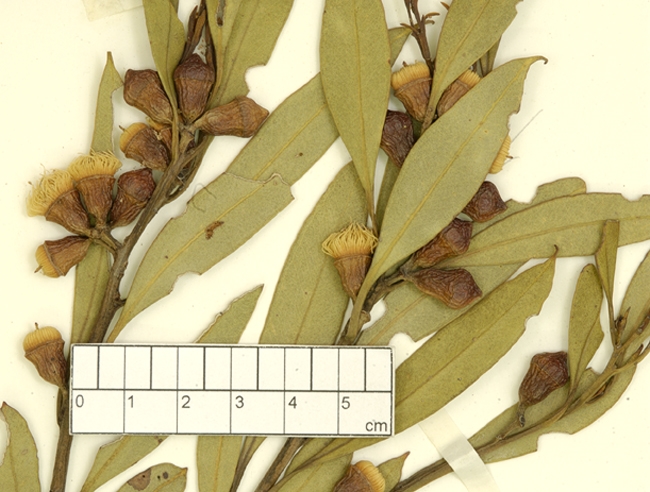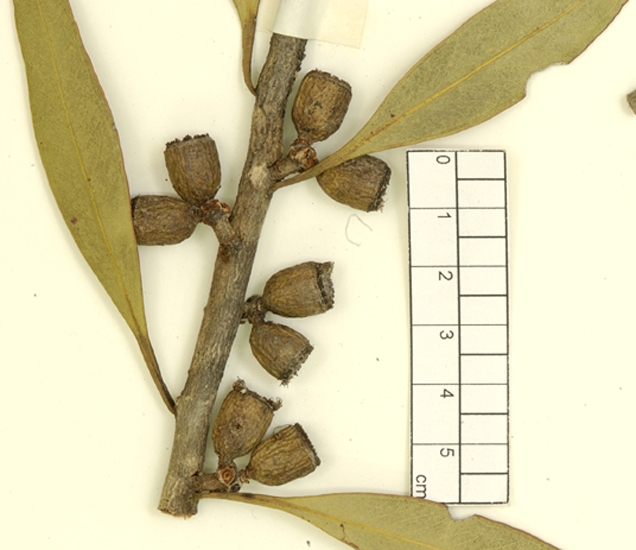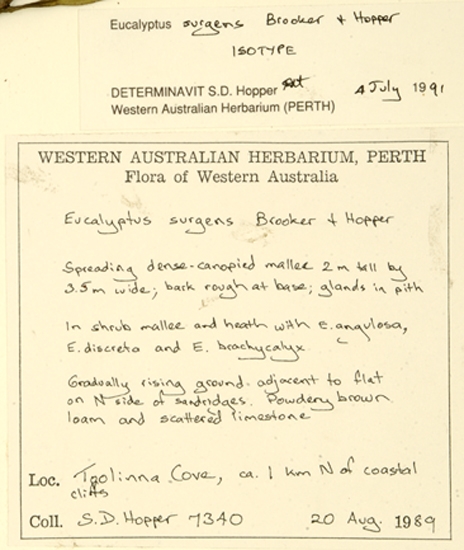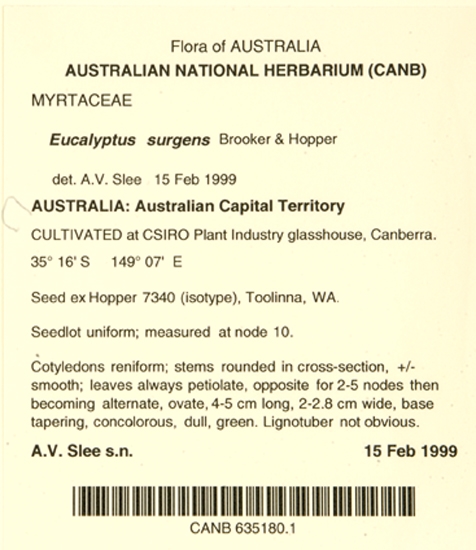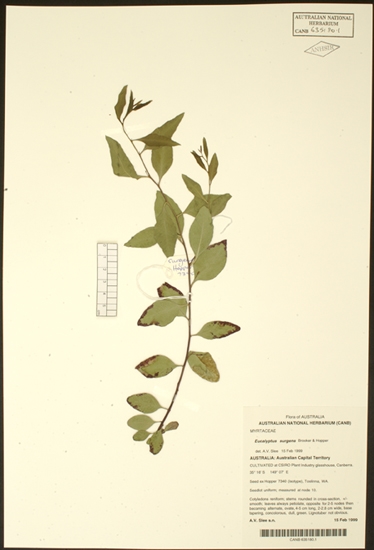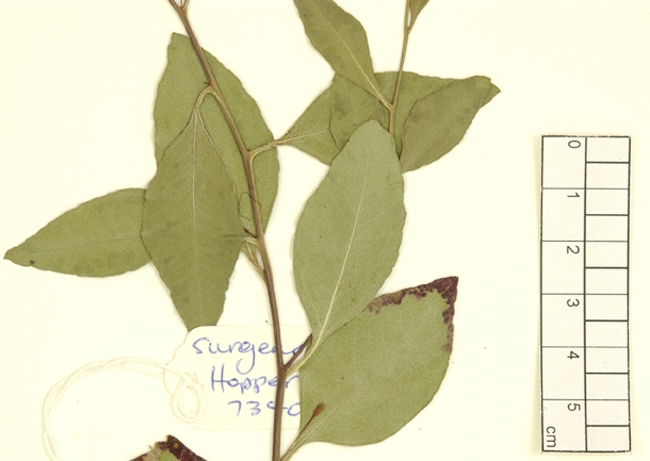Eucalyptus | Symphyomyrtus | Dumaria | Merrickianae
Euclid - Online edition
Eucalyptus surgens
Eucalyptus surgens Brooker & Hopper, Nuytsia 9: 53 (1993).
T: Toolinna Cove, ca 1 km north of coastal cliffs, 20 Aug. 1989, S.D.Hopper 7340; holo: PERTH; iso: CANB, NSW.
[Eucalyptus surgens Brooker & Hopper was made a synonym of the earlier published name Eucalyptus scyphocalyx (F.Muell. ex Benth.) Maiden & Blakely by D.Nicolle, M.E.French & K.R.Thiele (2012), Nuytsia 22(3) 107-108; see end of Notes hereunder for details. There are doubts about the validity of this and the name E. surgens continues to be used in EUCLID.]
Bark rough over basal 0.5 m (or less) of trunks, greyish and fibrous, smooth pale grey to creamy brown above, shedding in strips.
Branchlets have pale oil glands in the pith.
Juvenile growth (coppice or field seedlings to 50 cm): stems rounded in cross-section, smooth; leaves always at least shortly petiolate, alternate, elliptical lower on stem becoming narrowly lanceolate, 3.5–7 cm long, 1–1.5 cm wide, dull, grey-green becoming green up stem.
Adult leaves alternate, petioles 0.7–1.5 cm long; blade lanceolate, 5–11.5 cm long, 1–2.2 cm wide, base tapering to petiole, margin entire, apex pointed, concolorous, dull at first becoming glossy, green, side-veins at an acute or wider angle to midrib, reticulation moderate to dense, broken, intramarginal vein present, oil glands intersectional, largish, irregular.
Inflorescence axillary unbranched, peduncles slightly flattened, 0.3–0.7 cm long, buds 3 or 7, shortly pedicellate or virtually sessile, pedicels 0–0.2 cm long. Mature buds cylindrical (0.9–1.2 cm long, 0.5–0.7 cm wide), scar present (outer operculum falling early), inner operculum rounded and apiculate to more or less shortly and broadly conical (0.3–0.5 cm long), stamens inflexed, all stamens perfect (see below), anthers wedge-shaped, versatile, dorsifixed, dehiscing by longitudinal slits, style long and straight, stigma blunt to rounded, locules 4, the placentae each with 4 vertical rows of ovules. Flowers creamy white.
Fruit sessile or almost so, pedicels 0–0.1 cm long, cylindrical, 0.6–0.9 cm long, 0.7–1 cm wide, with scar left by shedding of outer operculum conspicuous and vertical on outside of rim, disc descending, valves 4, enclosed.
Seeds dark brown, 1.5–2.5 mm long, flattened ovoid, dorsal surface conspicuously pitted, margin shallowly toothed, hilum ventral.
Cultivated seedlings (measured at node 10): cotyledons reniform; stems square to rounded in cross-section; leaves always petiolate, opposite for 2 to 5 nodes then alternate, ovate to lanceolate, 4–8 cm long, 1.5–3.5 cm wide, dull, green to grey-green.
Flowering has been recorded in October.
A sprawling mallee endemic to Western Australia only found in cliff-top coastal dunes in remote country south-west of Caiguna where it grows with E. yalatensis, and E. aff. discreta
Eucalyptus surgens belongs in Eucalyptus subgenus Symphyomyrtus section Dumaria because the buds have two opercula, stamens are strongly inflexed, ovules are in four rows on the placentae and cotyledons are reniform. Within section Dumaria it is closely related to only one species, E. merrickiae, and these two species, with their pitted, ornamented seed, erect leaves, glandular pith, erect inflorescences with stout shortly pedicellate cylindrical buds, constitute the small series Merrickianae.
Eucalyptus surgens differs from E. merrickiae in its low shrubby habit, scant rough bark and ovate seedling leaves.
Another anomalous species in section Dumaria, E. deflexa, has similar seeds to both E. merrickiae and E. surgens but is a small smooth-barked mallee with conspicuous pendulous cream buds.
Eucalyptus surgens was originally thought to have staminodes (sterile stamens) but closer inspection of the type specimen showed that the visible stamens had been grazed, probably by some bird or insect. Dissection of unopened buds, and later inspection of many flowers in the field at Toolinna and at Currency Creek Arboretum, showed that stamens were always perfectly formed.
The earlier published name Eucalyptus scyphocalyx (F.Muell. ex Benth.) Maiden & Blakely was applied to Eucalyptus surgens by D.Nicolle, M.E.French & K.R.Thiele (2012). The type specimen of Eucalyptus scyphocalyx (F.Muell. ex Benth.) Maiden & Blakely, was collected by Maxwell from "Eyre's Relief Camp" (?near Rossiter Bay) and is of uncertain application in the field. This specimen consists of adult leaves and mature flower-buds. The leaves have consistently shorter petioles and narrower lamina relative to length than is the case with any specimens of E. surgens Brooker & Hopper (or specimens of E. sp. Southern Wheatbelt, which has also been called E. scyphocalyx previously). The lack of seeds with the Eucalyptus scyphocalyx type specimens precludes certainty in stating its identity with respect to existing field populations of E. surgens, E. merrickiae and E. sp. Southern Wheatbelt. The seeds of E. sp. Southern Wheatbelt are flattened ovoid grey-brown with a pale scurfy patch around the hilum and are un-pitted; those of E. surgens and E. merrickiae are dark brown flattened ovoid conspicuously pitted and ornamented.

